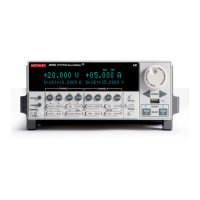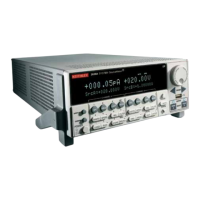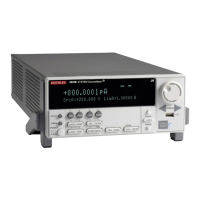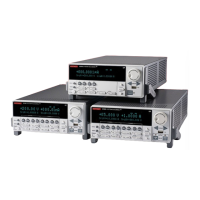2600S-901-01 Rev. C / January 2008 Return to Section Topics 14-11
Series 2600 System SourceMeter® Instruments Reference Manual Section 14: Display Operations
Saving a user script
After a user script is loaded into the Series 2600 it can be saved in non-volatile memory. If it is not
stored in non-volatile memory, the script will be lost when the Series 2600 is turned off.
When loading a script from the Test Script Builder, the launch can be configured to save the script
in non-volatile memory (see “
Using Test Script Builder” in Section 2).
When loading a user script from another program, myscript.save() is used to save the script in
non-volatile memory (see “
Saving a user script” in Section 2).
Adding USER TESTS menu entries
The following function can be used in two ways to add an entry into the USER TESTS submenu:
display.loadmenu.add(displayname, chunk)
display.loadmenu.add(displayname, chunk, memory)
displayname Name string to add to the menu.
chunk Chunk is the code to be executed.
memory Save or don’t save chunk and displayname in non-volatile memory.
Set memory to one of the following values:
0 or display.DONT_SAVE
1 or display.SAVE
The default memory setting is display.SAVE.
The chunk can be made up of scripts, functions, variables and commands. With memory set to
display.SAVE, commands are saved with the chunk in non-volatile memory. Scripts, functions
and variables used in the chunk are not saved by
display.SAVE. Functions and variables need to
be saved along with the script (see “
Saving a user script”). If the script is not saved in non-volatile
memory, it will be lost when the Series 2600 is turned off. See Example 1 below.
Example 1:
Assume a script with a function named “DUT1” has already been loaded into the Series 2600, and
the script has NOT been saved in non-volatile memory.
Now assume you want to add a test named “Test” to the USER TESTS menu. You want the test to
run the function named “DUT1” and sound the beeper. The following command will add “Test” to
the menu, define the chunk, and then save
displayname and chunk in non-volatile memory:
display.loadmenu.add(“Test”, “DUT1() beeper.beep(2, 500)”,
display.SAVE)
When “Test” is run from the front panel USER TESTS menu, the function named “DUT1” will
execute and the beeper will beep for two seconds.
Now assume you cycle power on the Series 2600. Since the script was not saved in non-volatile
memory, the function named “DUT1” is lost. When “Test” is again run from the front panel, the
beeper will beep, but “DUT1” will not execute because it no longer exists in the chunk.
Example 2:
The following command adds an entry called “Part1” to the front panel “USER TESTS” submenu
for the chunk “testpart([[Part1]], 5.0)”, and saves it in non-volatile memory:
display.loadmenu.add("Part1", "testpart([[Part1]], 5.0)",
display.SAVE)
